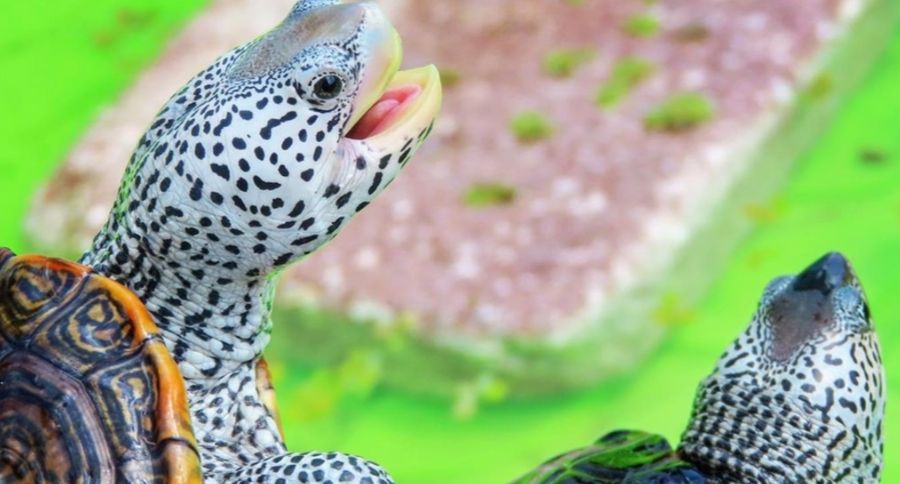Turtles can make great pets. They're easy to find and purchase, affordable, and eat minimal food. If you have a shelf or small table available in your room, you probably have room for a pet turtle. Plus, even if you live in an apartment with a no-pet policy, a landlord may be willing to make an exception for this small pet.
While turtles are a relatively low-maintenance pet when compared to a dog, they still need proper care to keep them healthy and happy. If you're thinking of getting a pet turtle, make sure that you understand the specifics of what that turtle will need, from basic turtle care to what it will eat to the type of habitat and enclosure it should have.
What Turtles Eat
Your turtle will need a diet that closely resembles what he would eat in the wild. According to Pet MD, most turtles will eat fish (like goldfish), insects, and leafy greens. Canned and pelleted turtle food is also available to help simplify the diet, and you can also supplement with freeze-dried mealworms.
You won't need to feed your pet turtle every day since, in the wild, your turtle wouldn't have food every day. Try to feed your turtle between four and five times each week. Younger turtles will need to be fed daily until they are adults.
In addition to its regular diet, you'll need to supplement your turtle with a calcium supplement. You will only need to add this supplement to their food twice a year, though.
Types of Turtle Enclosures
https://www.instagram.com/p/BspOzLGB5qH/
To keep your turtle healthy, you'll need to invest in a quality enclosure. According to Reptiles Magazine, you should purchase a large enclosure for your turtle. Glass aquariums are a practical and popular option for a turtle tank. Small turtles measuring between 4 and 6 inches once grown will need a 30-gallon tank at the minimum. Turtles measuring between 6 and 8 inches need a 55-gallon tank. Turtles larger than 8 inches need a 75-gallon or even 125-gallon tank. If your turtle is growing, you'll need to increase the size of his enclosure to accommodate his need for extra space.
If you can't use an aquarium, you might use a plastic tub, terrarium, or an indoor pond. For enclosures with water, keeping that water clean can be a big challenge. Investing in a good filtration system is a must, but it's important to regularly clean and maintain the filter.
Your tank won't need decorations, and filling the tank with decorations can make it more difficult to clean. However, your turtle must have a basking spot where they can completely climb out of the water and warm themselves under a light. This spot can consist of a rock, a commercially-made basking platform, or even a piece of wood.
Speaking of light, your turtle will also have specific light requirements. According to VCA Hospitals, your turtle will need a 100-watt incandescent bulb and light focused on his basking area. This light should warm the area to 75 to 88 degrees Fahrenheit.
Additionally, your turtle will need a light that produces UV-A and UV-B light. Turtles use UV light to produce vitamin D3, which helps them to absorb calcium. Without UV light, turtles can develop nutritional metabolic bone disease because they can't properly absorb calcium. Most lights made for turtles produce both UV-A and UV-B light, so be prepared to power both a UV light and a basking light in your setup.
Routine Care for Turtles
If you can give your turtle proper routine care, you can help to reduce the risk of your turtle developing an illness or other health issue. According to Pet MD, one of the most common issues that new turtle owners overlook is the importance of keeping a turtle's water clean. Turtles use the water as their bathroom, so they'll quickly get a clean tank dirty. Even with a water filtration system in place, you'll need to change your turtle's water at least a few times every week to maintain water quality. (If frequent water changes are an issue, you might want to choose a tortoise instead of a turtle, since they spend more time on land than in the water.)
It's also important to keep your turtle's habitat at an appropriate temperature since a habitat that's the wrong temperature can cause turtles to stop eating or to get an infection. The temperature should be the same temperature that the turtle would be exposed to in its natural habitat, so you'll need to do a little research based on the type of turtle that you have. You'll need to regulate both the air and water temperature.
Common turtle health issues include respiratory diseases, shell infections, parasites, and calcium deficiencies. If you notice that your turtle isn't behaving normally or seems to have a health issue, you will need to take your turtle to a vet. Only some vets treat turtles, so find a turtle specialist ahead of time before you actually need their help.
Bringing Home a Turtle
There are many United States turtle species that are ideal for dedicated new pet owners. You can often find a selection of different species of turtles at your local pet store, though you may want to travel to a store that specializes in turtles to help advise you on your first turtle. Remember, aquatic turtles and pond turtles are fun to watch, but they'll require more frequent water changes than a tortoise will. Be sure that you give some thought to the right turtle for you.
Caring for your turtle isn't too demanding, but having a pet turtle definitely requires some scheduled care. Remember that pet turtles can live for about 20 years, so be sure that you're ready for this long-term commitment before bringing home your new pet.
For turtle supplies, visit Chewy.
Have you ever lived with a pet turtle? Please leave us a comment below!
WATCH NOW: Why Pets Are the Best





